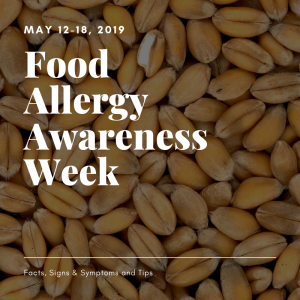Food Allergy Awareness Week
Food Allergy Awareness Week is May 12-18, 2019. On average, two children per classroom have some sort of food allergy. Below are some food allergy basics, signs and symptoms to watch out for, as well as some great resources on finding tons of information.
Food Allergy Basics
- Food allergies affect approximately 15 million Americans, including 6 million children.
- A food allergy is an immune system response to a food the body mistakenly believes is harmful.

- When a person with food allergy eats the food, his or her immune system releases massive amounts of chemicals, including histamine, that trigger a cascade of symptoms that can affect the respiratory system, the gastrointestinal tract, the skin, and/or the cardiovascular system.
- There is no cure for food allergies.
- The prevalence of food allergies appears to be increasing among children under the age of 18. On average, two students in every classroom have a food allergy.
- Although food allergy desensitizations are being studied, these are not yet proven treatments, so strict avoidance is the only way to prevent an allergic reaction.
- Managing a food allergy on a daily basis involves constant vigilance.
- Trace amounts of an allergen can trigger an allergic reaction in some individuals.
- Unfortunately, food allergy deaths do occur, even among persons with a history of mild reactions in the past.
- 9-1-1 must ALWAYS be called with every anaphylactic reaction.
Anaphylaxis
- Is a serious allergic reaction that comes on quickly and has the potential to become life-threatening.
- Symptoms can develop rapidly after exposure to an allergen, often within minutes and usually within 30 minutes. However, it can take up to 2 hours for symptoms to occur after exposure to a food allergen.
- Sometimes a second round (or “phase”) of allergic reactions can occur after the initial anaphylactic reaction. This is called “biphasic anaphylaxis.” A second reaction may happen as early as an hour after the first reaction or as long as 72 hours later (the average is 10 hours later) and can be less severe, as severe, or even more severe than the initial reaction.
- Anaphylaxis must be treated immediately with epinephrine (adrenaline).
A great resource: Signs And Symptoms Of Anaphylaxis poster can be found by clicking this link.
A food allergy is NOT:
- A food intolerance (lactose intolerance, gluten intolerance, etc.).
- An intolerance does not involve the immune system – it involves the digestive system because the body lacks an enzyme needed to digest and process a particular food.
- Symptoms of an intolerance include gas, bloating, and abdominal pain.
- A food preference (vegetarian, kosher, etc.).
- Celiac Disease (is a NON-IgE mediated food allergy).
Eight foods account for 90 percent of all food allergy reactions:
- Peanuts
- Tree nuts (cashews, pecans, walnuts, etc.)
- Milk
- Egg
- Wheat
- Soy
- Fish (halibut, salmon, etc.)
- Shellfish (crab, lobster, shrimp, etc.)
However, almost any food can cause a reaction.
_________________________________________________________________
For more information on Food Allergy Awareness, please visit this website: www.foodallergyawareness.org/
